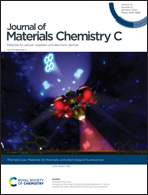A phosphorescent OLED with an efficiency roll-off lower than 1% at 10 000 cd m−2 achieved by reducing the carrier mobility of the donors in an exciplex co-host system†
Abstract
9,9′-Diphenyl-9H,9′H-3,3′-bicarbazole (BCzPh)-based molecules have been applied as donors in an exciplex co-host system in OLEDs to achieve high device performance. In this work, to investigate the effect of charge mobility of the donor on the performance of OLEDs using an exciplex co-host system, we synthesized two bipolar BCzPh analogs, i.e., BCzPh-pimi and BCzPh-mimi, by introducing 1-phenyl-1H-benzimidazole to the para- and meta-positions of the phenyl ring of BCzPh. The ΔEST values of BCzPh-pimi and BCzPh-mimi are 0.60 eV and 0.59 eV, respectively. In contrast, the ΔEST values of the exciplex formed by BCzPh-pimi and BCzPh-mimi with an electron acceptor, i.e., B3PyMPM, are 0.26 eV and 0.19 eV, respectively. In addition, the photoluminescence (PL) decay lifetimes of BCzPh-pimi and BCzPh-mimi increase remarkably from 5.39 ns and 9.46 ns to 247.79 ns and 263.21 ns, respectively, when mixed with B3PyMPM. The OLEDs fabricated by using BCzPh-pimi with B3PyMPM as an exciplex co-host for a green phosphorescence emitter, i.e., Ir(ppy)2(acac), exhibited a maximum external quantum efficiency (EQE) of 22.31%. Notably, the BCzPh-pimi-based device showed an extremely low efficiency roll-off. Its EQE was retained at 22.16% even at a high luminance of 10 000 cd m−2, corresponding to the efficiency roll-off of only 0.67%. Such an extremely low efficiency roll-off of the device can be attributed to the reduced hole mobility of BCzPh-pimi resulting from the electron-withdrawing benzimidazole moiety in the molecular structure of BCzPh, which improves balance in charge recombination in the exciplex co-host system of OLED devices at high applied voltages.

- This article is part of the themed collection: Materials for thermally activated delayed fluorescence and/or triplet fusion upconversion


 Please wait while we load your content...
Please wait while we load your content...